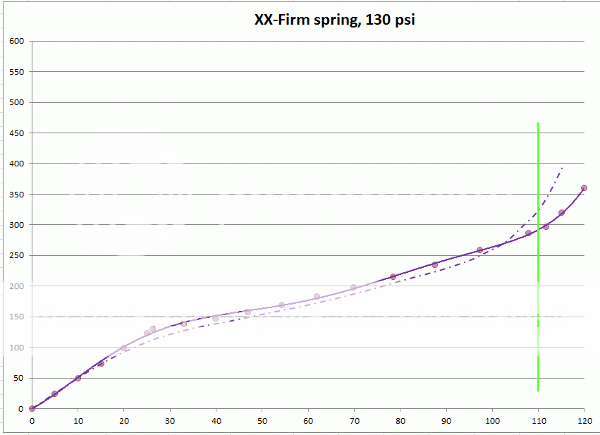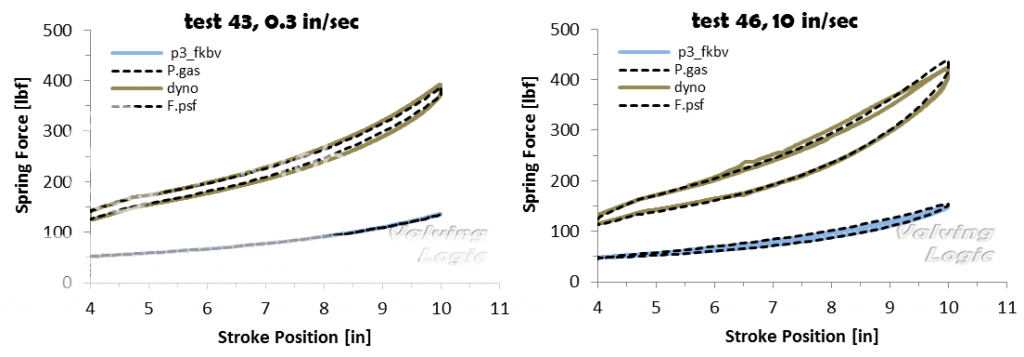Hi all,
I've got a Tower Pro 120 mm, with QR15 and tapered steerer. I've been riding it for some months without thinking too much on adjustments. I had it mounted on a new bike, and I had to get used to many different things..
I weigh around 155 lbs, so I started inflating it at 60 psi. I felt it much soft, so I added 10 extra psi after few weeks. I mainly rode it with this setting, but now and then I noticed some dive when braking, so I rose air pressure to 180 psi. It felt good on the trail, but I wanted to follow a more rigorous process to try and find the best tuning.
I've read a lot lately. The topic on clydesdales by TrailMaker has been very inspirational, and I'm re-reading the topic on abs+ tuning by mullen119. As @mullen119 underlines, the most important aspect in the fork's tuning is choosing the right spring.
I don't want to be under- or oversprung, and yesterday I did several test runs, inflating the Tower Pro's air spring at different air pressures. I started at 60 psi, and then I repeated the same trail at 70, 80, and 90 psi.
EDIT--Absolute+ LSC set to MAX-4. Rebound damping half way through--
The main part of the test was a steep descent with several big rough obstacles--rock gardens, drops, roots...
At 60 psi the ride was harsh at times on big hits (! likely because I have only 50 mm of travel left, because of huge brake dive?), and brake dive noticeable. Small bump compliance was excellent though.
At 90 psi it felt bumpy and again harsh on big hits. I didn't exploit full travel, but only 80 mm.
The best feeling was accomplished with 70 and 80 psi. Small bump compliance was better with 70. With 80 I felt more control. I used 110 and 100 mm of travel respectively. On the trail my choice was 70.
I shot some videos of the descent, to have something more objective than just riding impressions, and see how the fork responded with different pressures. Surprisingly, when I watch the videos I feel the better response is with 80 psi. With 70 it seems the fork is constantly too compressed when I brake (it's steep and I brake way too much!)
Here's the test video for the fork with 70 psi of air:
What do you think? I'm interested in your opinion, cause I don't have much experience in what I should actually expect, and the exact interpretation of terms like over and under sprung is not crystal clear to me. It's like the first times you taste wine--what is supposed to be good wine and what bad?
I believe you shouldn't waste an awful amount of travel just for brake dive. But is the dive in the above vid too much indeed?
I'll link the video for the 80 psi test in a following post.
I've got a Tower Pro 120 mm, with QR15 and tapered steerer. I've been riding it for some months without thinking too much on adjustments. I had it mounted on a new bike, and I had to get used to many different things..
I weigh around 155 lbs, so I started inflating it at 60 psi. I felt it much soft, so I added 10 extra psi after few weeks. I mainly rode it with this setting, but now and then I noticed some dive when braking, so I rose air pressure to 180 psi. It felt good on the trail, but I wanted to follow a more rigorous process to try and find the best tuning.
I've read a lot lately. The topic on clydesdales by TrailMaker has been very inspirational, and I'm re-reading the topic on abs+ tuning by mullen119. As @mullen119 underlines, the most important aspect in the fork's tuning is choosing the right spring.
I don't want to be under- or oversprung, and yesterday I did several test runs, inflating the Tower Pro's air spring at different air pressures. I started at 60 psi, and then I repeated the same trail at 70, 80, and 90 psi.
EDIT--Absolute+ LSC set to MAX-4. Rebound damping half way through--
The main part of the test was a steep descent with several big rough obstacles--rock gardens, drops, roots...
At 60 psi the ride was harsh at times on big hits (! likely because I have only 50 mm of travel left, because of huge brake dive?), and brake dive noticeable. Small bump compliance was excellent though.
At 90 psi it felt bumpy and again harsh on big hits. I didn't exploit full travel, but only 80 mm.
The best feeling was accomplished with 70 and 80 psi. Small bump compliance was better with 70. With 80 I felt more control. I used 110 and 100 mm of travel respectively. On the trail my choice was 70.
I shot some videos of the descent, to have something more objective than just riding impressions, and see how the fork responded with different pressures. Surprisingly, when I watch the videos I feel the better response is with 80 psi. With 70 it seems the fork is constantly too compressed when I brake (it's steep and I brake way too much!)
Here's the test video for the fork with 70 psi of air:
What do you think? I'm interested in your opinion, cause I don't have much experience in what I should actually expect, and the exact interpretation of terms like over and under sprung is not crystal clear to me. It's like the first times you taste wine--what is supposed to be good wine and what bad?
I believe you shouldn't waste an awful amount of travel just for brake dive. But is the dive in the above vid too much indeed?
I'll link the video for the 80 psi test in a following post.







